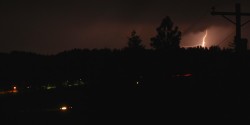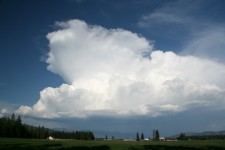Being inside a substantial building or inside a vehicle is best when caught in a thunderstorm. But if you happen to be outside and unable to seek a safe shelter, there are ways to reduce the risk of being struck by lightning.
The National Weather Service advises to: 1) immediately get off elevated areas such as hills, mountain ridges and peaks, 2) never lie flat on the ground, 3) never shelter under an isolated tree, 4) never use a cliff or rocky overhang for shelter, 5) immediately get out and away from ponds, lakes and other bodies of water and 6) stay away from objects that conduct electricity like barbed wire fences and power lines.
Where should you go then?

Lighting can illuminate clouds during an approaching storm. Don’t wait to see the lightning bolt or hear thunder until you seek shelter. If the storm cloud is within six miles, you are in a high danger zone.
To avoid direct strikes and streamers, avoid high places and open ground. Once you hear thunder, immediately head for safe terrain if you are in a high place. If everywhere is open and you don’t have time to descend, try to find a depression or ravine to take shelter. Once there or if you are caught in the open, assume the lightning position to become a smaller target.
The lightning position means crouching as best as you can on the balls of your feet with your heels touching (like a ballerina), with your head down and your arms hugging your legs (to help you keep the position longer). You can also put your hands over your ears to protect your ears from the loud thunder since it will be close to you. Don’t let your hands touch the ground.
Keeping your heels together (off the ground) provides a short path for the electrical charge to enter and leave your body, thus minimizing the chance of it entering the rest of your body. If you have a foam pad, crouch on top of it to add protection from ground currents.
The National Outdoor Leadership School (NOLS) advises the sitting lightning position where you sit on a foam pad with your legs bent in front of you so you are hugging your legs. With your feet still on the ground, there is less distance for the ground current to travel. NOLS recommends this position because it can be held for a longer period of time.
Don’t lay flat because there is more distance for ground current to travel through you.
Never seek shelter under an isolated tree or any tall tree in the area since they can produce side flashes.
If you are in the forest, seek a group of small trees surrounded by tall trees or look for a ravine or depression. Stay away from open meadows and stay several feet from tree trunks if moving through the forest to lower elevations to avoid side flashes.
Wet ground in a ravine isn’t any more dangerous than dry ground (wet ground actually dissipates ground current faster) but avoid standing in water.
If you are traveling in a group, spread out so everyone is 50 feet apart to reduce multiple injuries while in the lightning position.
Avoid cave entrances, mine tunnels or rock overhangs because arcs can cross the openings.
If the hair on your arms or legs begins to tingle and stand on end, lightning is imminent. Immediately (seconds matter) drop down, move away from backpacks and assume the lightning position. Only run to shelter if it is a few seconds away.
If you are outside when a thunderstorm is approaching, the best way to avoid a lightning strike is to find safer terrain, avoid tall or isolated trees and assume the lightning position.
You are never 100 percent safe from lightning. When you can’t seek shelter, remember the lightning position to reduce the risk of being struck by lightning when there are no other options.




